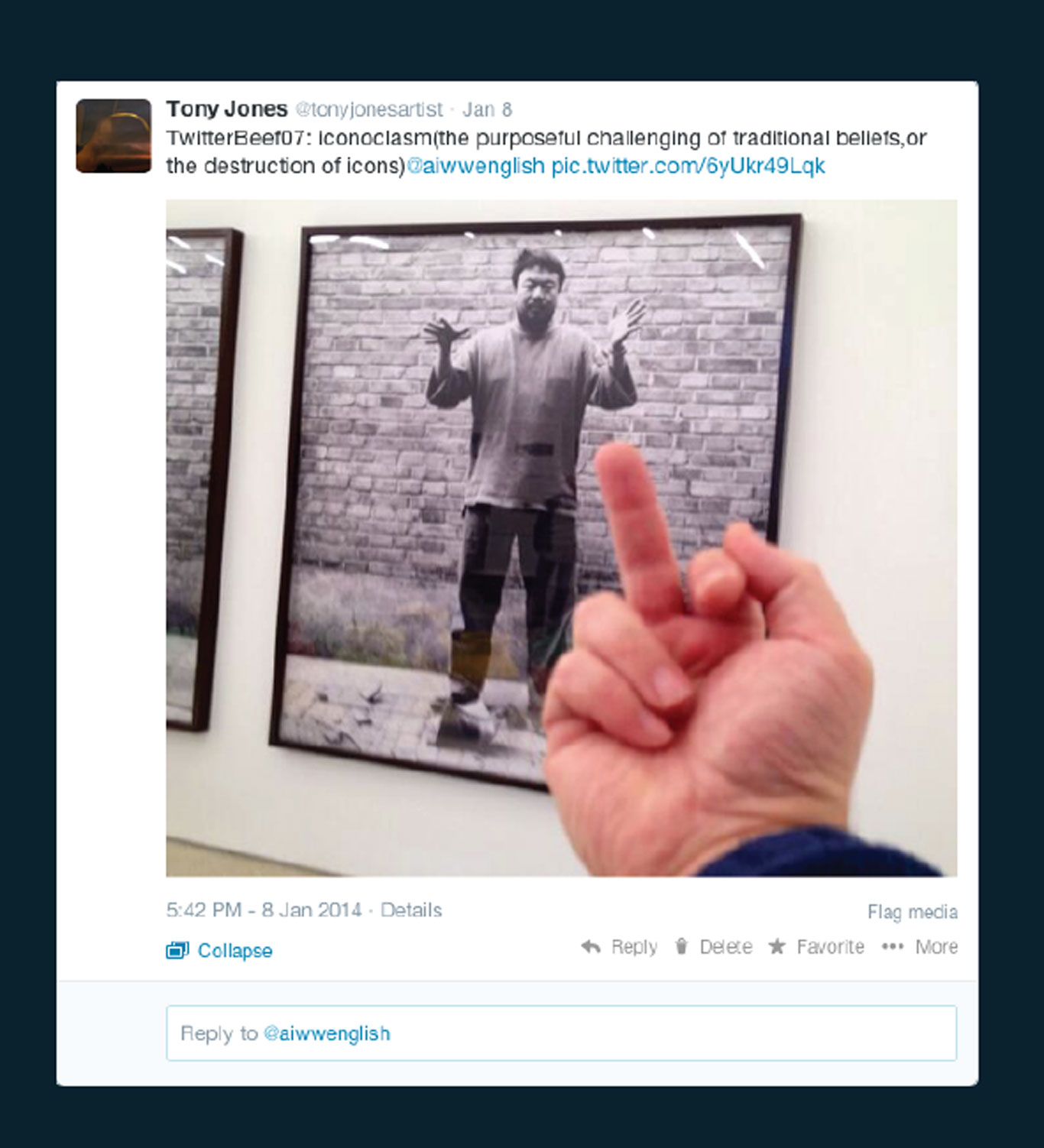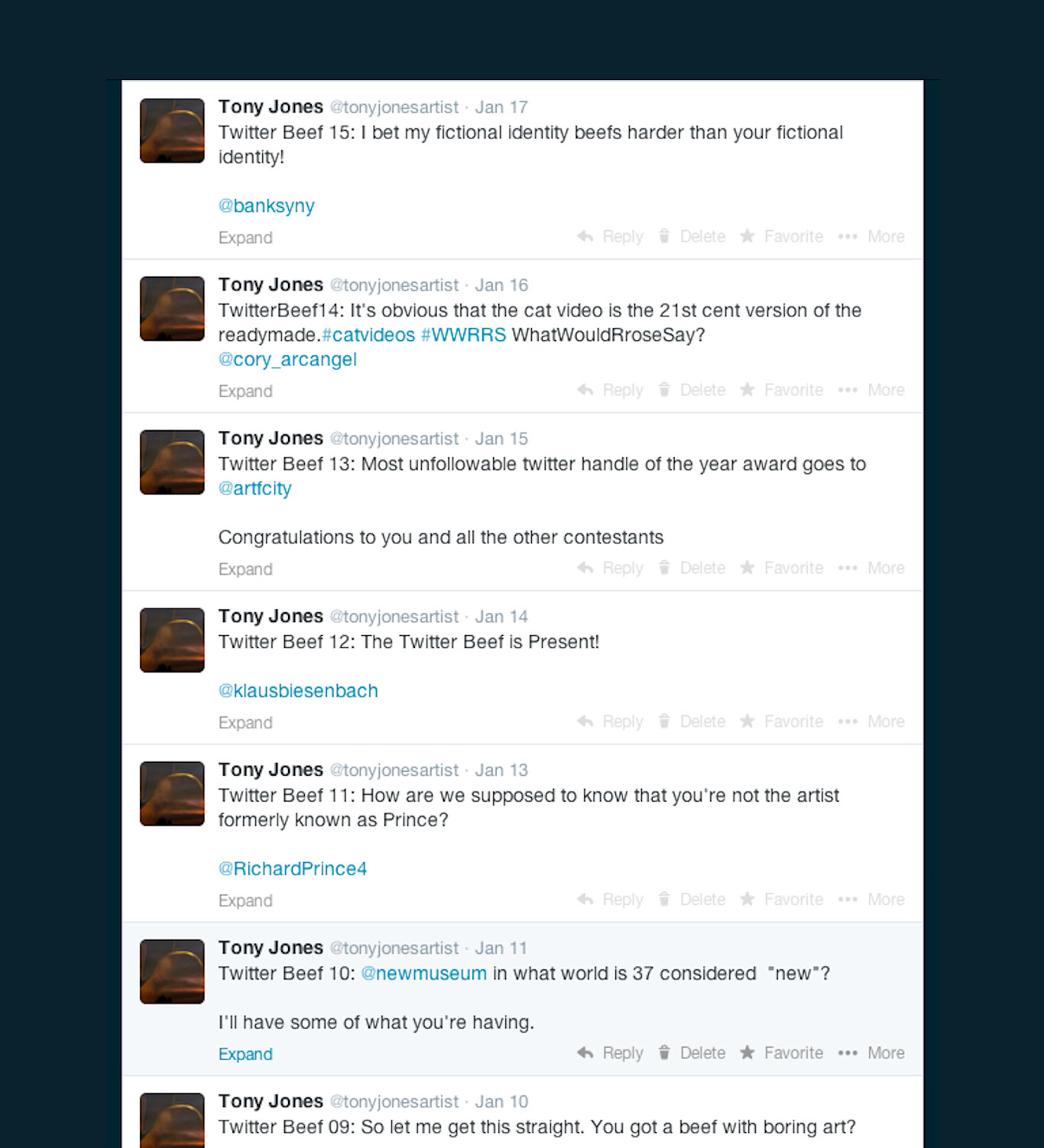Tony Jones


018: Twitter Beefs
My art praxis has been drawn to the ongoing progression of technology. With Light is Free, I began exploring the nuances of device-based artwork. The handheld device ensures that a portable art making machine is available on a continuous basis. An artist no longer needs to carry a camera, a sound recorder, a telephone, a laptop computer, a musical instrument, a book or a journal. All of these are housed within a single computer.
Nonetheless, the question persists, how does one take a social device and transform it into a tool of artistic expression? I was also interested in expanding my critique of mainstream artists. All too often, famous artists are afforded a fashionable level of creative license. In short, they are no longer bound by the constraints of quality. Most famous artists sustain their careers due to the eminence of their brand name.
One of the ways I decided to explore this fascination was by working with the social networking site Twitter. The application allows for the universal transmission of 140-character instant messages. These messages can be viewed, altered and redistributed by the spectator almost immediately. The ability to instantly post and follow ensures that the user acts as an author and reader of content. Similar to the “authorless” theories posited by Roland Barthes and Vilém Flusser, Twitter forms a dialogical instance of text-based communication. Text becomes a tool that is mutually distributed and received by anyone within the network.
Another fascinating attribute is the ability to communicate across boundaries of class, culture, time, space and status. This facet is often noticeable when celebrities, politicians, and athletes use Twitter. In this scenario, personalities who are typically segregated from quotidian sectors are transformed into everyday participants. Furthermore, these elite personalities often use Twitter as a digital messenger. Rather than rely on the mainstream media to shape persona, celebrities can post direct messages that don’t require secondary sources. Through technology, a famous personality is able to communicate directly to the masses.
Having pierced these walls of exclusivity, Twitter displays multiple chains of networked conversation. The application also provides an opportunity to air grievances with other celebrities. Colloquially referred to as “Twitter beefs”, celebrities, athletes, and politicians will voice disagreements with their counterparts within the digital network. If the attacked party responds, several messages are often exchanged between celebrities. This text-based form of call and response eventually develops into a comprehensive “Twitter beef.” In a touch of irony, famous personalities send direct messages that are technically, and shamelessly, indirect. As a consequence, a raw form of documentation is available to the spectator. They are able to witness a spectacle without necessitating television, cinema, sporting events or elections.
With the Twitter Beefs project, I relocated the practice of virtual beefing into the arena of the art world. I have included my statement of action. A full account of all twenty beefs can be viewed by following Twitter handle @tonyjonesartist.
I, Tony Jones, promise to use the following considerations while beefing:
1. Never beef down. Only beef up. It is not necessary to beef with artists who are in my immediate circle. I will only beef with celebrity artists or mainstream institutions. Ultimately, I want to see if the beef is taken seriously. Will they feel the need to respond?
2. Beefs are not personal attacks. I hold no ill will towards the art personalities with whom I will beef. My goal is too communicate with members of the art world who possess a certain level of privilege. Although I am mocking their aura of exclusivity, I am also interested in communicating with these personalities. These beefs are questioning the concept of exclusivity and should not be taken as personal attacks.
3. Will beefs receive responses? I’m most curious to see if any of the beefs receive feedback. In Twitter, responses can arrive in the form of retweets, direct messages or favorites. I’ve suggested that Twitter is a way to diminish the presence of the author – to create a dialogical community of writers and readers. By engaging in the Twitter beef project, I will evaluate the extent of my beefs. Will they inspire an equality of communication or will they reinforce the status quo?
My art praxis has been drawn to the ongoing progression of technology. With Light is Free, I began exploring the nuances of device-based artwork. The handheld device ensures that a portable art making machine is available on a continuous basis. An artist no longer needs to carry a camera, a sound recorder, a telephone, a laptop computer, a musical instrument, a book or a journal. All of these are housed within a single computer.
Nonetheless, the question persists, how does one take a social device and transform it into a tool of artistic expression? I was also interested in expanding my critique of mainstream artists. All too often, famous artists are afforded a fashionable level of creative license. In short, they are no longer bound by the constraints of quality. Most famous artists sustain their careers due to the eminence of their brand name.
One of the ways I decided to explore this fascination was by working with the social networking site Twitter. The application allows for the universal transmission of 140-character instant messages. These messages can be viewed, altered and redistributed by the spectator almost immediately. The ability to instantly post and follow ensures that the user acts as an author and reader of content. Similar to the “authorless” theories posited by Roland Barthes and Vilém Flusser, Twitter forms a dialogical instance of text-based communication. Text becomes a tool that is mutually distributed and received by anyone within the network.
Another fascinating attribute is the ability to communicate across boundaries of class, culture, time, space and status. This facet is often noticeable when celebrities, politicians, and athletes use Twitter. In this scenario, personalities who are typically segregated from quotidian sectors are transformed into everyday participants. Furthermore, these elite personalities often use Twitter as a digital messenger. Rather than rely on the mainstream media to shape persona, celebrities can post direct messages that don’t require secondary sources. Through technology, a famous personality is able to communicate directly to the masses.
Having pierced these walls of exclusivity, Twitter displays multiple chains of networked conversation. The application also provides an opportunity to air grievances with other celebrities. Colloquially referred to as “Twitter beefs”, celebrities, athletes, and politicians will voice disagreements with their counterparts within the digital network. If the attacked party responds, several messages are often exchanged between celebrities. This text-based form of call and response eventually develops into a comprehensive “Twitter beef.” In a touch of irony, famous personalities send direct messages that are technically, and shamelessly, indirect. As a consequence, a raw form of documentation is available to the spectator. They are able to witness a spectacle without necessitating television, cinema, sporting events or elections.
With the Twitter Beefs project, I relocated the practice of virtual beefing into the arena of the art world. I have included my statement of action. A full account of all twenty beefs can be viewed by following Twitter handle @tonyjonesartist.
I, Tony Jones, promise to use the following considerations while beefing:
1. Never beef down. Only beef up. It is not necessary to beef with artists who are in my immediate circle. I will only beef with celebrity artists or mainstream institutions. Ultimately, I want to see if the beef is taken seriously. Will they feel the need to respond?
2. Beefs are not personal attacks. I hold no ill will towards the art personalities with whom I will beef. My goal is too communicate with members of the art world who possess a certain level of privilege. Although I am mocking their aura of exclusivity, I am also interested in communicating with these personalities. These beefs are questioning the concept of exclusivity and should not be taken as personal attacks.
3. Will beefs receive responses? I’m most curious to see if any of the beefs receive feedback. In Twitter, responses can arrive in the form of retweets, direct messages or favorites. I’ve suggested that Twitter is a way to diminish the presence of the author – to create a dialogical community of writers and readers. By engaging in the Twitter beef project, I will evaluate the extent of my beefs. Will they inspire an equality of communication or will they reinforce the status quo?